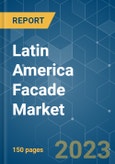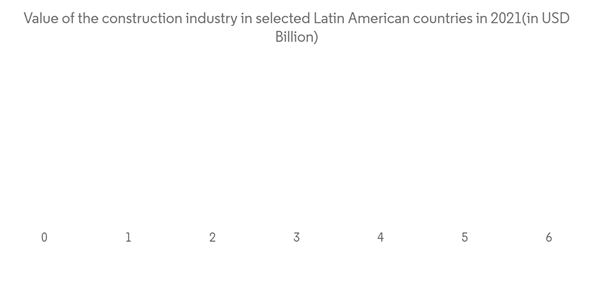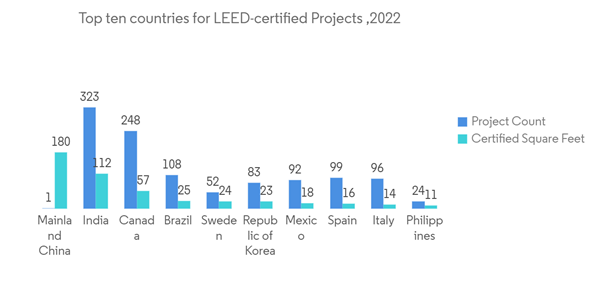Key Highlights
- Due to rapid urbanization, Latin American countries have been scaling-up green buildings, in some cases achieving significant reductions in energy consumption, water use, carbon dioxide emissions, and solid waste.
- In addition, facade provides various benefits in making energy-efficient buildings with low solar penetration, passive cooling, reduced overheating, and lower air conditioning costs, which is further expected to support the demand for facades over the forecast period.
- Factors such as the growing construction industry supported by favorable government assistance and inclination toward constructing green buildings are impacting the infrastructural projects, thereby positively driving the growth of the facade market. Also, the penetration of advanced insulation material, UPVC, and double skin facades are higher than other materials, as it improves the energy efficiency of the building. Moreover, the advent of sophisticated technologies, such as precast facade panels, is projected to generate ample growth in the facade market. However, the high cost of raw material and installation and repair costs are expected to hamper the growth of the facade market.
- The COVID-19 outbreak halted the market's expansion. According to the Brazilian Institute of Geography and Statistics, the construction sector in Brazil experienced a 1% year-over-year decline in the first quarter of 2020 and a 6.7% quarter-over-quarter decline.
- The outbreak of COVID-19 is likely to bring several short-term and long-term consequences in various industries, including a major impact on the construction industry, which has affected the facade market. Work interruptions due to lockdown measures imposed by governmental authorities negatively affected the commercial, residential, infrastructural, and institutional sectors, decreasing the demand for facade installations. Such lower demand from the commercial and residential construction sectors is expected to hinder the demand for facade materials during the short term.
Latin America Facade Market Trends
Increasing Construction Sector Boosting the Demand for Facade Installations
The construction industry is one of the main sectors of the Mexican economy and the most important in terms of market value in all of Latin America. In the year 2022, the construction industry contributed approximately 7% of Mexico's GDP.In the year 2021, the production value in the construction sector in Mexico was around 281,000 million Mexican pesos (USD 14.8 billion). This represented a recovery of almost 2,000 million pesos (USD 106 million) compared to the production value reported in 2020.
Last year the Brazilian Government ended the Minha Casa Minha Vida program to implement the new Casa Verde e Amarela housing program. Under the program, the Government aims to regularize up to 2 million homes and renovate over 400,000 over the next four years in the country. Hence the demand for facade installation is also expected to increase.
The market in Mexico is expected to exhibit high growth shortly due to increasing remodeling and renovation activities in the residential construction sector which drives facade installations.
To meet growing market demand in Latin America and provide higher product availability Vitro, a glass manufacturing company has planned to build a new float furnace at Vitro’s Garcia plant near Monterrey, Mexico. The company has invested more than USD 120 million in this new facility last year.
Construction activity is anticipated to increase due to the expansion of the residential, commercial, and industrial sectors brought on by continuous economic growth, which will ultimately drive the Latin America facade market demand over the forecast period.
The rapidly growing population, the rising construction sector, and the increasing number of fire incidents are some of the major drivers expected to boost the growth of the Latin America facade market over the forecast period.
Raise in Demand for LEED-certified Green Buildings is Expected to Propel the Facade Market
Green eco-friendly facades provide better air quality, noise damping, and natural beauty. Increasing awareness towards zero emission and energy-efficient buildings together with the growing demand for fully-recyclable facade boards is expected to propel the market growth of the facade market size.Today, Latin America has over 2,100 LEED projects in Argentina, Bolivia, Brazil, Chile, Colombia, Costa Rica, Ecuador, El Salvador, Guatemala, Guyana, Honduras, Mexico, Nicaragua, Panama, Paraguay, Peru, Surinam, Uruguay, and Venezuela.
The Latin American market is seeing steady growth due to the rising demand for facade materials. The market is especially driven by the innovation of environmentally friendly materials, especially in Brazil where the customers are poised to be more receptive to the materials for renovating or redeveloping buildings.
The US Green Building Council (USGBC) announced that Mexico ranks ninth in the world on its annual list of the top 10 countries and regions for LEED in 2021. Brazil is the other Latin American country to appear on the 2021 list and is ranked number seven.
For instance, in Brazil, Eco Berrini Building uses glass facades that are orientated away from direct sunlight which in turn reduces electricity consumption of lighting systems and air conditioning.
In Columbia, the Urban Development Company building uses a prefabricated facade system composed of high-quality elements that allow the outside cold air to be directed towards an external chimney, generating, and influencing thermal mass on the interior.
Argos Tower, Columbia building is composed of two independent towers that are integrated under one roof, forming a single L shaped building. The shape and glass facade take advantage of sunlight, using it for natural lighting.
Thus the market for eco friendly facades is driven by an increase in demand for LEED-certified green buildings in Latin America.
Latin America Facade Market Competitor Analysis
The report covers major players operating in the Latin America facade market. The market is highly fragmented and competitive, with large companies claiming significant market share.Several key players engage in collaborations, innovations, business expansion, awards and recognition, joint ventures, and other strategies to improve their offerings and remain competitive in the market.
Leading players in the market include Tecnoglass Inc, Roofway, Ventanar, Estudio Marshall & Associates, Mallol Arquitectos, Au-Mex, Dante Tisi, PFEIFER Structures, Shackerley (Holdings) Group, ULMA, BFG International, etc.,
Additional Benefits:
- The market estimate (ME) sheet in Excel format
- 3 months of analyst support
Table of Contents
Companies Mentioned (Partial List)
A selection of companies mentioned in this report includes, but is not limited to:
- Tecnoglass Inc
- Roofway
- Ventanar
- Estudio Marshall & Associates
- Mallol Arquitectos
- Au-Mex
- Dante Tisi
- PFEIFER Structures
- Shackerley (Holdings) Group
- ULMA
- BFG International
Methodology

LOADING...










